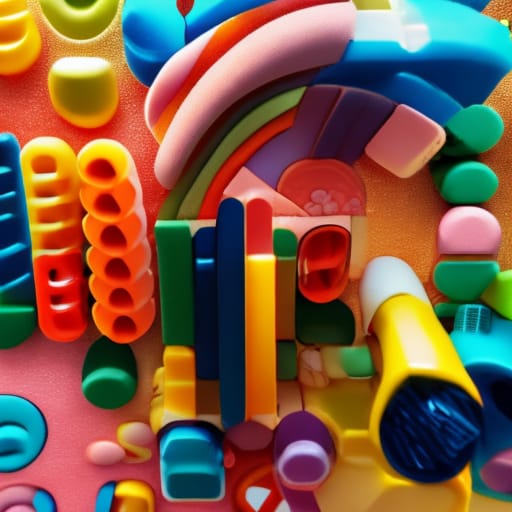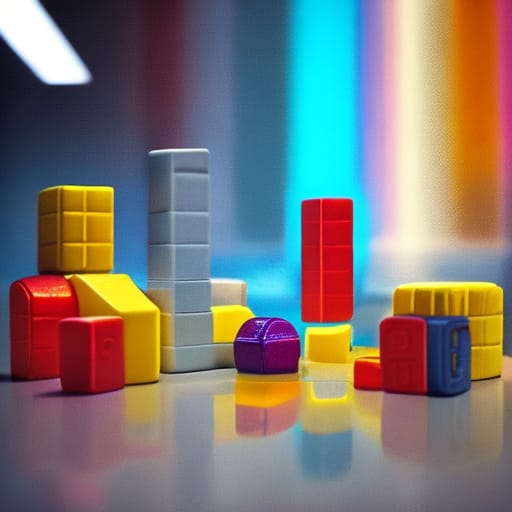Brightly colored blocks clung together in midair, slowly taking the shape of a house. Tiny hands rotated and clicked the pieces in place, experimenting with angles and balance. A misplaced block sent the whole structure tumbling down, but laughter soon followed along with the patter of small feet gathering up the scattered blocks to try again. Magnetic building blocks invite open-ended play and exploration for children, engaging their minds in STEM learning. With multiple sets now available featuring different shapes, sizes, and magnetic properties, these toys build key cognitive abilities along with creativity and problem-solving skills. This beginner’s guide will explain what magnetic building blocks are, their educational benefits, and tips for maximizing play value with your budding builder.
An Introduction to Magnetic Building Blocks
- Magnetic building blocks, often called magnetic tiles or magnetic 3D blocks, refer to colorful plastic pieces that use embedded magnets to attach to each other.
- Sets come in different geometric shapes like squares, triangles, rectangles, and diamonds with magnetic poles allowing connection on all sides and in 3 dimensional formations.
- This magnetic construction capacity promotes STEM learning through building structures and encourages creative expression through imaginative play.
- Research shows toddlers using magnetic blocks demonstrate improved spatial reasoning, logic skills, and hand-eye coordination.
- Magnetic blocks ranked in the Amazon Top 20 Bestselling Preschool Toys of 2022, making them a popular mainstream toy with proven developmental benefits.
The appeal of magnetic blocks comes from the satisfaction of clicking pieces together to create buildings, vehicles, mosaic art, and more while exploring engineering concepts like balance, geometry, and polarity firsthand. The creative possibilities are endless, limited only by children’s burgeoning imaginations. Sets now integrate added play value through themes like marble runs, race car tracks, zoo animals, and more. As an open-ended toy with no prescribed building outcomes, magnetic blocks stretch cognitive capabilities and problem-solving unlike fixed construction sets. Their reconfigurable nature ensures endless combinations for ongoing curiosity and discovery.
Key Features of Magnetic Building Blocks
Magnetic building sets share certain core components but vary in shape selection, magnetic strength, accessories, and play themes. Below outlines common elements across the most popular sets:
- Magnetic Building Pieces: Colorful, lightweight plastic blocks in geometric shapes like squares, triangles, diamonds etc. made with embedded magnets to connect through magnetic force. Larger sets feature more shape variety and piece sizes for expanded building options.
- Accessories: Some sets incorporate special pieces like windows, doors, wheels, animals, trees, and road pieces for added play value. Marble runs, race car ramps, storage containers etc. increase functionality.
- Strong Magnets: Sets are calibrated to the best safety standards but offer enough magnetic force for stable, vertically-stacked structures needed in STEM building. Poor quality magnets unable to hold weight risk collapse and frustrate children.
- Premium Quality: Reputable brands use long-lasting, BPA-free ABS plastic for safe use passing strict toy testing protocols for choking hazards etc. Tough material withstands regular use without cracking or paint chips.
- Reconfigurability: Core benefit of open-ended play comes from the ability to continually reconfigure pieces into new structures without limitation. Higher piece counts support more variety.
- Portability: Lightweight blocks in handy storage bags or containers allow porting sets between rooms or on trips to extend play opportunities.
Pay attention to the magnetic strength, durability, piece variety, and extras available when comparing magnetic block sets for the best value. Poor quality sets with weak magnets, flimsy pieces, and lack of shape options will limit play possibilities and imagination. Investing a little more in reputable toy brands ensures years of fruitful building activity.

Defining Educational Aspects
Magnetic blocks offer exceptional educational value for toddlers through school-aged children by building vital skills across crucial developmental areas:
Spatial Reasoning: Stacking blocks in three dimensions enhances understanding of spatial relationships, depth perception, balance, and geometry.
Creativity: Open-ended play without set building outcomes boosts innovation, self-expression and problem-solving.
Logic & Strategy: Experimenting with magnetic polarity, stability, and gravity through engineering builds critical thinking.
Fine Motor Control: Precision required to handle small pieces improves dexterity, grip strength and eye-hand coordination.
Early STEM Concepts: Foundations of engineering, physics, design, and mathematics manifest through trial and error block construction.
Cooperative Play: Collaborating on building projects teaches teamwork, communication, and compromises vital for social-emotional growth.
These cognitive abilities form crucial neural connections for later academic success and career opportunities in technical fields. Magnetic blocks unwrap the magic of imagination-fueled play essential for holistic development.
Evaluating Magnetic Block Sets
With the popularity of magnetic tiles, dozens of manufacturers now offer sets marketed for open-ended STEM education. Prices range wildly from $20 starter packs to $300 mega sets with thousands of pieces. While more blocks allow bigger builds, you need not spend a fortune to gain substantial play value. Here are key considerations when selecting magnetic blocks:
Child Age Range: Check manufacturer guidelines on appropriate ages. Toddlers need large, basic pieces. Older kids appreciate more variety and challenge.
Piece Size: Larger pieces suit younger kids best for easier manipulation. Older children enjoy mixing small and large pieces.
Shape Variety: Simple squares allow straight lines while triangles, diamonds and rectangles enable curves, patterns and textures.
Specialty Pieces: Windows, doors, wheels etc. enhance role play. Extra building surfaces like playboards extend possibilities.
Strong Magnets: Blocks should securely attach on all sides without needing perfectly flush alignment. Weak magnets greatly diminish play potential.
Safety Standards: Reputable brands adhere to toy safety protocols so verify regulatory compliance like CE marks.
Storage: Convenient bags/containers keep pieces organized and allow portability which maintains playtime value.
While entry-level basic kits serve introduction well, opting for value packs around $50-100 with 100-200+ quality pieces in various sizes generally sustains engagement best without breaking bank.
Maximizing Educational Value
Beyond selecting quality magnetic blocks optimized for STEM learning, parents play a key role in cultivating vital developmental benefits during play sessions. Here are tips to guide your budding builder:
- Let them experiment freely without judging and offer encouragement when they get frustrated with structures collapsing. Process matters more than the product.
- Ask open-ended questions about their choices rather than directing building outcomes. Foster problem-solving confidence through trial and error.
- Suggest new materials besides blocks to raise project possibilities e.g. incorporate string, paper, crayons etc. Think 3D poster art, jewelry, mosaic canvases.
- Build collaboratively together and narrate thought processes aloud regarding shape, balance, measurement etc. to demonstrate STEM thinking.
- Assign fun building challenges e.g. tallest tower in 5 minutes incorporating specified colors/shapes to stretch skills.
- Capture builds with photos over time and playback as slideshows to showcase progress and provide a sense of achievement.
Avoid relegating magnetic blocks as just another toy. Their capacity as an early introduction to engineering makes them a launchpad for cultivating a passion for technical creativity and innovation. With thoughtful guidance, you can empower the next generation of inventors.

Case Study: PicassoTiles 60 Piece Set
With over 18,000 reviews on Amazon, PicassoTiles ranks among the most popular magnetic building block sets that promise STEM enrichment. This 60 piece starter set made from BPA-free plastic provides varied shape selection for creative building play.
Key Specs:
- 60 plastic pieces in 5 colors
- Square, rectangles, triangles, diamonds
- Sizes from 0.5” to 3” thickness
- Portable zippered bag for storage
- Dimensions: 10” x 5” x 5”
- Weighs 2.43 lbs.
This mid-size set stretchesbeginners through offering four distinct shape types to enable combining straight lines and curved textures in builds. Triangle corner alignment allows fluid 30° rotation of structures. Smaller pieces help detail facades with precision unavailable from large bricks alone.
Magnets embedded in each block securely connect to all other pieces regardless of alignment angles. Strong magnetic adhesion prevents frustrating collapses mid-build which inspires confidence to keep reaching higher vertically. Multiple reviewers used over 300 pieces without structural integrity issues.
Despite the deceivingly simple components, users consistently highlight the engineering lessons realized through trial and error testing of shape arrangements, polarity, balance, alignment angles and weight distribution. Figuring optimal arrangements teaches key principles of geometry, spatial reasoning and critical thinking. Toddlers have fun clicking the pieces together while elementary kids challenges themselves creating elaborate castles, mazes and artwork pushing creative boundaries.
The lightweight plastic bag simplifies storage whether using blocks at home or porting them for travel. Zipping pieces securely prevents losing them. While the 60 piece set supports solo play sufficiently, many parents opt to purchase add-on sets to amass more bricks for collaborative projects. Overall, PicassoTiles remain the bestselling magnetic blocks on Amazon by delivering reliable quality matched with essential STEM building play value at reasonable prices.
Top 5 Magnetic Block Sets
While PicassoTiles provides a reputable jumping in point for magnetic block construction play, many alternatives exists across capability levels and price ranges. Below compares the most popular building block set options that optimize STEM learning:
| Set | # of Pieces | Shape Variety | Extras | Price |
|---|---|---|---|---|
| Magna-Tiles Clear Colors 32 Piece Set | 32 | Squares & Triangles | Storage Bag | $49.99 |
| Playmags 100 Piece Premium Building Set | 100 | 6 Shapes & Sizes | Wheels, Windows, Animals, Trees | $99.95 |
| Magformers 30 Piece STEM Building Set | 30 | Squares & Triangles | Guide Cards | $44.99 |
| Quercetti 50 Piece Geomag Magnetic Building Set | 50 | Circles, Squares & Triangles | None | $34.95 |
| PicassoTiles 100 Piece Magnet Building Tiles | 100 | 4 Shapes & Sizes | Storage Bag | $39.95 |
With distinct magnet types from steel balls to neodymium, polarity orientation and shape/size variety impacts structural engineering creativity and difficulty. More complex builds challenge older kids while simpler configurations suit toddler fine motor skills.
Always verify manufacturer recommended age groups for safety and choking hazard avoidance. While cards suggest building ideas, open-ended play sans instruction has greatest cognitive benefits. Budget at least $35-40 for introductory sets with around 30-50 pieces and $100+ for 100-200+ pieces to sustain progressive skills. Consider add-on expansion packs once basics are mastered.
Final Thoughts
With the exponential growth in STEM career opportunities, building kids’ interest and competencies forms crucial foundations for future success. Magnetic blocks unlock engineering principles through joyful hands-on discovery rather than dry textbook theories. As your tiny tinkerers relish clicking these colorful pieces together in every imaginable configuration, they tacitly explore scientific concepts underpinning construction fundamentals.
More than just a screen-free toy, guided block play helps construct key cognitive abilities empowering the next generation of innovative thinkers. So foster your budding builder’s aspirations one magnetic block at a time!
Frequently Asked Questions
What are the best magnetic blocks for toddlers?
For toddlers, opt for larger sized blocks around 0.5-1 inch thickness with basic shapes like squares, rectangles and triangles. Bright colors captivate their attention and strong magnets prevent frequent crashing. Sets under $50 like Magna-Tiles Clear Colors provide good value.
How do magnetic blocks teach STEM skills?
Trial and error constructing vertical and horizontal structures teaches engineering, spatial reasoning, geometry, and physics fundamentals. Figuring optimal shape arrangements for stability and alignment angles builds critical thinking across technical domains.
What age are magnetic blocks appropriate for?
Magnetic blocks suit children typically 18 months through 8 years old. However, always verify manufacturer guidelines on appropriate ages. Simple sets with large pieces work well for younger toddlers while older kids appreciate more variety and complexity promoting advanced STEM learning.
How can magnetic blocks improve development?
Magnetic blocks support crucial cognitive growth across areas like creativity, logic, strategy, 3D visualization, fine motor skills and early mathematics through open-ended play. Building collaborative projects also teaches teamwork, communication and social skills.
Are magnetic building blocks safe for kids?
Reputable magnetic block sets from established brands meet all federal safety standards for children’s toys. They use BPA-free, non-toxic ABS plastic so pieces pose no hazardous choking risks or lead exposure dangers. However, adult supervision remains vital for safe play.
